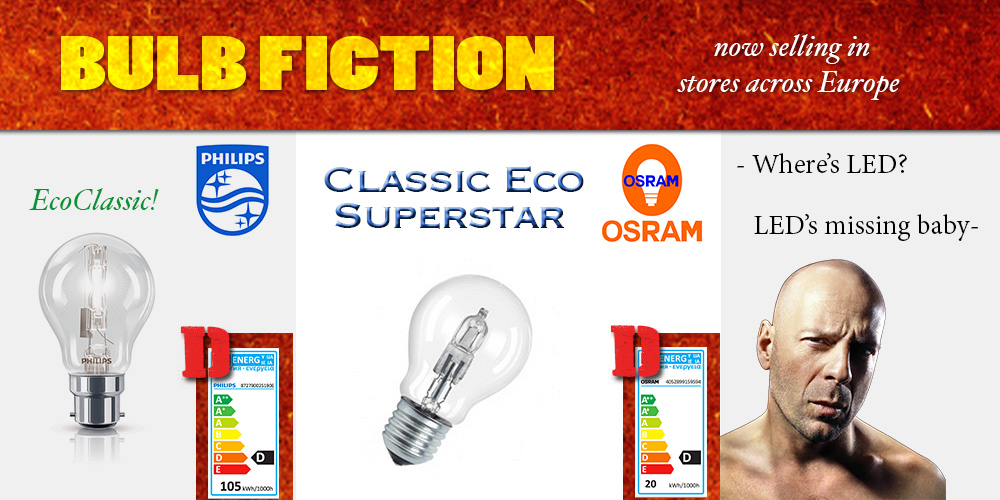The most inefficient light bulbs are being sold as ‘eco’ by major brands across Europe, an investigation by Coolproducts has found, just as the UN launches the International Year of Light and Light-based Technologies.
Halogen bulbs are 10 times more wasteful than today’s best real eco alternatives according to the latest research, earning them a typical EU energy label grade of D or C, compared to an A++ for the best LED bulbs. Using halogens will typically drive up energy bills by £40 (US $60) per year compared to true eco alternatives, according to UK experts.
But inspections online, in highstreet stores and supermarkets in the UK, Denmark, Germany, Belgium, France, Italy and Spain (see Spanish shop images for example) has revealed Philips, Osram and others packaging numerous inefficient halogens as ‘EcoClassic’ and ‘Classic Eco Superstar A’ for example, complete with nature imagery. The bulbs are in fact class D. In France, AllVision markets at least one halogen (front / back) as 'energy saving'.
 |
|
Halogen lamps sold by Philips and Osram might not meet advertised energy efficiency standards. (Source: Coolproducts) |
EU law specifically stops firms using the phrase 'energy saving lamp' when marketing halogens, but does not mention the term 'eco'. However, EU guidance clearly rule that in this context 'eco' is same as 'energy saving lamp' (FAQ, page 32 - Question on the use of the term 'energy saving lamp'). It seems the legal department of Philips and Osram will have a busy year, with Coolproducts in France submitting a complaint with the country's advertisement regulation authority and member state authority and the authorities in Denmark and Sweden already alerted.
Halogens are only eco in comparison to incandescent bulbs that Philips and Osram know were phased-out years ago, yet this packaging is modern. Whether greenwash or consumer manipulation, the effect is the same: people think they are getting energy savers when in fact they are buying the worst bulbs on the market. They would be far better off buying LEDs or CFL bulbs from forward-thinking retailers like IKEA. The point was more or less admitted by an OSRAM official in a Swedish twitter exchange back in October.
At the UN's big opening bash in Paris today, first sponsored by Philips, the firm's lighting CEO Eric Rondolat asked the audience to close their eyes and imagine what it must be like in some developing world villages after dark. No doubt the firm is doing good work to promote LEDs overseas, and we applaud its many progressive interventions over the years, not least on EU lawmaking. We just wish it wasn't also asking European consumers to close their eyes when they go to buy new bulbs. How many marketing people does it take to change a light bulb packet? We're not sure, but with so many twitter accounts bombarding today's UN event hashtag #IYL2015 (@PhilipsNL @PhilipsBeLux @PhilipsItalia @PhilipsLight @PhilipsEU @PhilipsPR and head of global public & government affairs for lighting @Harry_Verhaar no less) we were surprised nobody had an answer to this question.
Trade body LightingEurope opposes a long-agreed ban of class C or lower non-directional light bulbs that would end sales of most halogens, due to take effect in September 2016. It wants to push back the ban to 2020, perhaps because halogens are more profitable than the alternatives. It convinced the European Commission to postpone the ban, with lobby letters that repeat the misleading ‘eco’ halogen claim. Ironically, LightingEurope tried to undermine some of the LED bulbs in the latest research mentioned above not on the grounds of their awesome performance, but on their packaging. Their arguments seem a little feeble to us, but worryingly, some member states are thought to be backing a freeze of the long-agreed phase-out of wasteful halogens. The matter will be voted on by member state officials in Brussels in the coming weeks.
The EU situation is in stark contrast to India, where on 5 January prime minister Narendra Modi launched a drive for mass LED adoption and called on celebrities to help popularise the bulbs.












